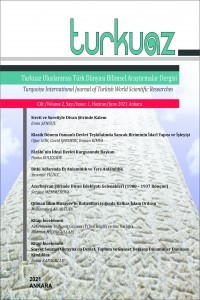İngilizceyi Yabancı Dil Olarak Öğrenen Türk Öğrencilerin Belirsizlik Toleransına İlişkin Bir Araştırma
Bu çalışma, Türkiye bağlamında İngilizceyi yabancı dil olarak öğrenen hazırlık okulu öğrencilerinin belirsizlik toleransını ölçmeyi amaçlamaktadır. Ayrıca, İngilizce öğrenmeye ilişkin belirsizlik toleranslarında Türk erkek ve kız öğrenciler arasında istatistiksel olarak anlamlı bir fark olup olmadığını incelemek araştırmanın amaçları arasındadır. Bu amaçla, Türkiye’de bir devlet üniversitesinde İngiliz Dili Eğitimi ve İngiliz Dili Edebiyatı bölümlerinde okuyan 89 (52 kız ve 37 erkek) hazırlık sınıfı öğrencisine Ely'nin (1995) İkinci Dilde Belirsizlik Toleransı Ölçeği (SLTAS) uygulanmıştır. Araştırmanın bulguları, katılımcıların düşük düzeyde belirsizlik toleransına sahip olduklarını ortaya koymuştur. Cinsiyet etkisine gelince, İngilizce öğrenmeye ilişkin belirsizlik toleranslarında erkek ve kız öğrenciler arasında istatistiksel olarak anlamlı bir fark görülmemiştir. Elde edilen bulgular ışığında İngilizce öğretmenleri ve araştırmacılar için de bazı çıkarımlar ve önerilerde bulunulmuştur.
Anahtar Kelimeler:
belirsizlik toleransı, cinsiyet, yabancı dil öğrenimi, İngilizceyi yabancı dil olarak öğrenen Türk öğrenciler
An Investigation into Turkish EFL Learners’ Ambiguity Tolerance
The purpose of this study is to explore Turkish EFL learners’ ambiguity tolerance at a state university, Turkey. In line with this main aim, to find out if there is any significant difference between Turkish male and female learners in their ambiguity tolerance of learning English is also another purpose of the study. Within this purpose, Ely’s (1995) Second Language Tolerance of Ambiguity Scale (SLTAS) was administered to 89 (52 female and 37 male) prep class students from Department of English Language Teaching and English Language Literature at a state university of Turkey. The data were collected during the academic year of 2018-2019. The findings of the study revealed that the participants’ ambiguity tolerance levels were low. There was not any statistically significant difference in students’ ambiguity tolerance of learning English regarding their gender. Based on the findings, implications and recommendations were also presented for teachers and researchers in the field of English language teaching.
___
- Atamanova, I., & Bogomaz, S. (2014). Ambiguity tolerance as a psychological factor of foreign language communicative competence development. Procedia-Social and Behavioral Sciences, 154, 345-352.
- Brougher, J. Z. (1984). Elementary teacher perceptions of and responses to ambiguity (tolerance). Dissertation Abstracts International, Section A: The Humanities and Social Science (DAI-A), 45(04), 1071.
- Brown, H. D. (2000). Principles of language learning and teaching (4th ed.). New York: Pearson Education Company.
- Chapelle, C. A. (1983). The relationship between ambiguity tolerance and success in acquiring English as a second language in adult learners. (Unpublished doctoral dissertation). University of Illinois, Urbana-Champaign, USA.
- Chapelle, C., & Roberts, C. (1986). Ambiguity tolerance and field independence as predictors of proficiency in English as a second language. Language Learning, 36, 17-45.
- Ehrman, M. E. (1993). Ego boundaries revisited: Toward a model of personality and learning. In J. E. Alatis (Ed.), Strategic interaction and language acquisition: Theory, practice, and research (pp. 330-362). Washington, DC: Georgetown University.
- Ellis, R. (1994). The study of second language acquisition. Oxford: Oxford University Press.
- Ely, C. M. (1989). Tolerance of ambiguity and use of second language strategies. Foreign Language Annals, 22, 437-445.
- Ely, C. M. (1995). Tolerance of ambiguity and the teaching of ESL. In J. M. Reid (Ed.), Learning styles in the ESL/EFL classroom (pp. 87-96). Beijing: Foreign Language Teaching and Research Press.
- Erten, I. H., & Topkaya, E. Z. (2009). Understanding tolerance of ambiguity of EFL learners in reading classes at tertiary level. Novitas-Royal, 3(1), 29-44.
- Frenkel-Brunswik, E. (1949). Intolerance of ambiguity as an emotional and perceptual personality variable. Journal of Personality, 18, 108-143.
- Furnham, A. (1995). The relationship of personality and intelligence to cognitive learning style and achievement. In D. H. Saklofske, & M. Zeidner (Eds.), International handbook of personality, and intelligence (pp. 397–413). New York: Plenum Press.
- Kamran, S. K., & Maftoon, P. (2012). An Analysis of the Associations between Ambiguity Tolerance and EFL Reading Strategy Awareness. English Language Teaching, 5(3), 188-196.
- Kazamia, V. (1999). How tolerant are Greek EFL learners of foreign language ambiguities? Leeds Working Papers in Linguistics, 7, 69-78.
- Li, H., & He, Q. (2016). Ambiguity Tolerance and Perceptual Learning Styles of Chinese EFL Learners. English Language Teaching, 9(6), 213-222.
- Naiman, N., Frohlich, M., Stern, H., & Todesco, A. (1978). The good language learner. (Research in Education Series No.7). Toronto: Ontario Institute for Studies in Education.
- Oxford, R. L. (1999). Anxiety and the language learner: New insights. In J. Arnold (Ed.), Affect in language learning (pp. 58–67). Cambridge: Cambridge University Press.
- Rubin, J. (1975). What “the good language learner” can teach ss. TESOL Quarterly, 9(1), 41-51.
- Senfeld, L. (1996). Math anxiety and its relationship to selected student attitudes and beliefs (Doctoral dissertation, ProQuest Information & Learning).
- Tegano, D. W. (1990). Relationship of tolerance of ambiguity and playfulness to creativity. Psychological Reports, 66, 1047-1056.
- White, C. (1999). Expectations and emergent beliefs of self-instructed language learners. System, 27(4), 443-457.
- Yin, Y. (2005). The influence of tolerance of ambiguity on English learning and its enlightenment on English teaching. Foreign Language World, 2, 58-61.
- Başlangıç: 2020
- Yayıncı: Eğitim ve Bilim Politikaları Araştırma Derneği
Sayıdaki Diğer Makaleler
Safevi Devleti’nin Hindistan’daki Müslüman Türk Sultanlıkları ile İlişkileri
Kitap İncelemesi: Osmanlı – İran Siyasi İlişkileri (1720-1747)
Azerbaycan-Türkiye Millî Marşlarının Edebî ve Müzikal Açıdan İncelenmesi
Belgin BAĞRIAÇIK, Miraç Ilgın YILDIZ, Kürşat Rüzgar YELİN, Adem YÜZGEÇ
